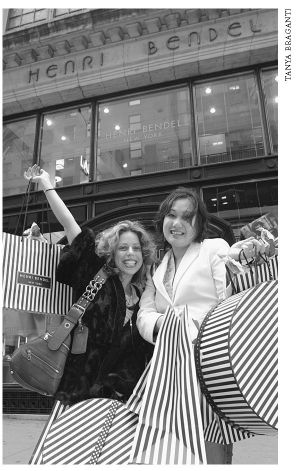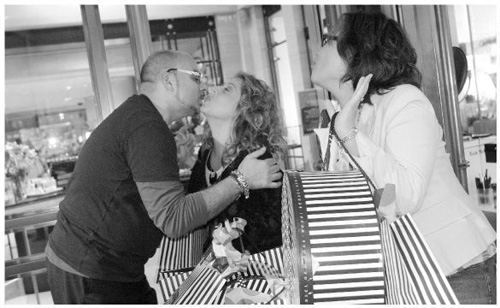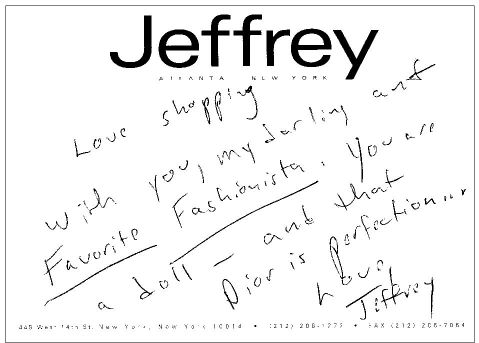The Fashionista Files (11 page)

CLOSET MAKEOVERS WITH SUPERSTYLIST MICHAEL PALLADINO
We had heard about legendary stylist Michael Palladino for years. Michael’s clients call him from hospital rooms after plastic surgery saying, “Michael, I’m thinking plunging necklines! I’ve got breasts now and they’re gorgeous!” Michael tells them to hang up and call back when they’re off the Demerol. “I’m not taking advantage of their weakened state to sell them fashion,” he says. As director of client and studio services of Henri Bendel, one of the city’s most cherished department stores, one of his services is to weed out the good from the bad and the unnecessary from the racks—and his clients’ closets—and help them fill the gaps in their wardrobes. We invited him to do ours.
Michael arrives at Mel’s apartment and immediately sifts through her closet like a madman. Mel wants to know which items to keep and which to discard, as she is moving all the way to Los Angeles, the land where the height of fashion is a Juicy sweatsuit and a pair of Uggs. Mel is a bit of a pack rat, and has kept every trend she has worn. He roots through and throws away all of her old, faded J.Crew dresses (“I didn’t peg you as a preppy!”) as well as several itchy and unflattering sweaters. Gone are the white vinyl miniskirts and the bulky wool tops. “Too many dark colors, too much black; for Los Angeles we need to get you into a color palette, something vibrant,” he decides.
At Karen’s, Michael takes one look at her walk-in closet and begins to toss beloved items in the “go” pile: an Imitation of Christ eighties prom dress that he describes as “part of the Cyndi Lauper therapy fund,” a Morticia Adams–style lace cardigan, and a Balenciaga dress with too many trends in it (topstitching, denim, leather, flounce). He tells Karen, “You have such a fun, whimsical style. What you really need are connectors, things to carry you through life and daytime. You have all of these wild event clothes that most women would never have the guts to wear. So let’s find you some basics. I’d like to see you in things that will last a lifetime, not just through a great party.”
We all pile into a cab and head to Henri Bendel to do some shopping. It’s the first time we have made use of a stylist, and we realize how helpful it can be to have an objective eye take a look at your wardrobe and run around the store to pull things for you. Fashionistas sometimes live in too much fantasy, and it’s good to have an outside voice ground you in reality. (We decide we must make use of this service more often, especially since every department store from Macy’s to Bergdorf has a personal shopper department to provide styling advice.)
At Bendel, the three of us dash from floor to floor. Michael grabs things while an assistant hangs them on rolling racks and carts them off to our respective dressing rooms. After MP’s closet analyses, we are focused with specific tasks at hand in order to meet each of our needs. Mel holds up a Plein Sud shearling. “Lightweight, Mel, lightweight!” Michael barks. Karen ogles more event clothes. “This white marabou jacket, is it a connector?” she asks. Michael shakes his head, staring at his shoes like a disapproving parent who always knows best.
We fall in love with all things Missoni, but the price tags ($2,500 for a coat Mel lives for) don’t allow us to consummate, and Mel, again, reaches for fur! This time, a rabbit-lined Juicy sweatshirt. (“What, it’s Juicy,” she rationalizes. “You said I need Juicy.”) She’ll never learn! Every time MP shows Karen practical connectors like a cargo skirt or a decent raincoat, she protests, “
Boring!
” and points to a crazy pair of black sequined cigarette pants and pleads, “Can’t this connect?”
“Sure,” he says sarcastically, “it’s perfect for running out to get the paper.” He is determined to help us break bad habits and make our lives whole. He finds several cool mod shift dresses and light chiffon skirts for Mel that she can wear tripping along in flipflops in Cali. But for Karen, he gives up. “You want flash. That’s who you are. Stick to it.” He brings her a micromini satin black corset Luella Bartley dress and tosses her a knit hat that says “
Slut.
”

We came. We saw. We shopped.
“Oh, Michael. You know me so well,” she says approvingly. Le pièce de résistance: a Swarovski-encrusted Agent Provocateur riding crop, which Karen uses to spank him (and Mel). Inspired, he brings her a long Rick Owens oxbloodcolored part-chiffon skirt, which she turns into a strapless dress by lifting it above her breasts (elastic waist) and twisting the extra fabric around her body to cinch it, closing it with a brooch. He adds in the fleece jacket Mel wanted and—voilà!—screams, “Yes! A connector!”

Saying good-bye to Michael, double-air kisses
With that, we are royally escorted out the glass double doors on Fifth Avenue. We hop in our chariot—a yellow taxi—with dozens of delicious Henri Bendel signature brown-and-white-striped bags. Ah, life is sweet.
How to Organize Your Closet
The secret to a well-dressed fashionista is a well-organized closet.
Fold jeans, don’t hang them, and pile them on a shelf. This way they occupy less space.
Never hang leather pants; always fold. Hanging stretches the leather.
Organize clothing by group: pants, sexy tops, button-downs, skirts, dresses, coats and jackets, each should have its own section. Within sections and subsections, organize by color, so things are easy to find.
Don’t hang the pieces of your suits together. Keeping them separate may inspire new outfits.
Don’t fret about seasonality. If you don’t have storage space to keep winter clothes when it’s summer and summer clothes when it’s winter, it’s fine to keep it all together (the seasonless closet). Just stick to the groups per above.
Fold sweaters and keep on a shelf. Arrange in piles according to color and thickness.
Keep dry-cleaning bags to a minimum. They tend to “suffocate” the clothes. Clothes must breathe, just like people.
Consider fur storage. Fur should be kept in optimum temperature conditions.
Nail hooks on the wall for your hats, bags, and belts.
CLEANING OUT THE CLUTTER
Some of your clothes will never come back in style. It’s a hard fact of life you will, at some point or another, have to face. There is no better way to make room for the new than to clean out the old. Getting rid of the things you don’t wear and will probably never wear again is not always easy, but it’s an occupational hazard that is par for the course. If you’re not sure what to keep and what to trash, follow our guidelines. But don’t feel like you have to follow things too closely. There are a bunch of dresses lurking on hangers in our closets that we refuse to give up, no matter what.
What to Give Away
Trendy one-season wonders.
Whatever you haven’t worn in over two years.
The stuff that’s way too small on you. It’s too much pressure to squeeze back into it. You’ll feel better about yourself if you don’t have a constant reminder of your weight gain.
The frump that’s too big on you.
Whatever you never really, really wholeheartedly loved in the first place.
Whatever looks a bit too worn and is too costly to repair. An $800 dress with patches of missing sequins deserves fixing, but a trendy dress from H&M with aging fabric does not.
Reminders of old flames. You don’t need the karma of an ex in your future. Exorcise your demons and make room for new fashion memories.
Tip: If you are afraid to let go of something, take it out of your closet, fold it, and put it in a box someplace else. Let time go by. If you don’t miss it, it’s your sign to take the next step . . . to Goodwill.
CHAPTER 3

The Shopping Commandments:
One False Move and You’re in the
Back of a Magazine with

a
Black Bar Over

Your Face

Now that you understand the essential building blocks of the fashionista closet, it’s time to shop, darling, shop. For fashionistas, shopping is a full-contact, hard-core sport that leads to joyous feelings of triumph and victory (“Oh, my God! I finally got that red leather jacket, the one I’ve been saving up for, the one in all the magazines! And there was only one left in my size. And it’s only because someone returned it just as I walked in the store. It was meant to be! Such a coup!”) as well as the agony of defeat (“I shouldn’t have bought this. I can’t afford it. I feel sick. I’m out of control. I’m a bad person.”).
We are a nation of consumers. No doubt shopping is one of the most pleasant ways to spend an afternoon, bonding with your mom, your friends, your new boyfriend’s sister. It can be the ultimate escape, a mind-altering, deliciously dizzying buzz. The excitement typically begins in the mind the second that we fashionistas decide to take a shopping excursion. As we near our desired location, the spring in our step gets bouncier. Our pace gets faster. Our heart rates increase as if we were in an aerobic boxing class. Our breath deepens. If you were to monitor our cardiovascular signs, the graph would be as wild as the stripes of a Missoni dress.
Shopping can also be a vehicle to fill a void (Warning: It doesn’t really fill that void, even when you think it does in the moment). Stanford University Medical Center published studies that claim that compulsive shopping disorder (CSD) is an actual illness, likened to alcohol and drug addictions, which can be so destructive that it disrupts daily life. Sufferers actually feel like the only thing that will make them okay is the pièce de résistance of le moment—a new cashmere blanket, leather pants, a white moleskin coat, even Puma sneakers. (They’re limited-edition, Ma! I had to have them!)
Telltale Signs of CSD
You believe that whatever you buy will make things all right.
You’re unable to think about anything other than shopping.
After the high of the buy, you’re overcome with guilt, remorse, regret.
Every time you buy, you swear you won’t do it again for X amount of time, knowing full well you will.
You forgo important bills (or responsibilities) in order to get something new.
You lie about what you spend.
You’re powerless over shopping desires.
Shopping is, let’s be honest, a frivolously fun way to relive the girlish innocence of playing dress-up (with one trip to the dressing room and a few hangers in our mitts, we can be Madonna circa 1984, the prom queen, Kate Moss). No wonder it’s often better than therapy and more therapeutic than sex (retail orgasm!). It can be a quick fix to cure a bad day. And while it may give you an instant high—the smell of new clothes, racks of fine threads, a community of like-minded people who understand your fashion fantasies—it can also be a dastardly way to come face-to-face with your mental demons, especially body image (ugh, don’t get us started on the mental wars we’ve fought over our thighs).
Let’s forget the negative shopping side effects and focus on the good ones! As a fashionista, you must appreciate every type of shopping destination, bitchy, prodding salespeople aside. We’re talking all: flea markets (where else can you boast, “I got this for two dollars!”?), discount designer outlets like Loehmann’s (last year’s designer must-haves are always on a rack or two), department stores (and their amazing seasonal sales), mass-market retailers like Kmart, Wal-Mart, and Target (the best place for your basic ribbed tanks), small posh boutiques (personalized service!), army-navy stores (authentic camouflage pants and peacoats are very important), and anyplace where you can exchange monetary denominations for material goods. Call us a sentimental breed, but we hate leaving without taking a little token of our experience with us, be it a sweater, a denim skirt, another white button-down shirt, or some supercute socks.
Fashionistas also have all sorts of shopping philosophies, specific rituals they follow, knowingly or not, and particular getups they like to wear while shopping. Every shopper has his or her own belief system. A religion, if you will. The two of us certainly have ours. They’re often different, but we have each learned from the other and expanded our horizons—and closets—throughout the journey of our friendship. Just remember, no matter what your manifesto, nothing is set in stone. Changing your mind—and MO—is as simple as returning a dress to Saks if you have your receipt. In your shopping career as a fashionista, it will be important to figure out what works for you and what doesn’t.
Think of this chapter as your guide to shopping well. We coach you through various shopping creeds, bargain hunting and thrifting tactics, the beauty of putting things on hold, and the extravagance of big-ticket items (everyone needs at least one!). We provide tips for surviving and succeeding at sample sales and spotting knockoffs, and show you the difference between being a fashion victim and a fashion maven. In addition, we introduce you to the benefits of consignment shops, eBay, and the occasional faux (a.k.a. fake). We walk you through shopping destinations anyone can reach, whether you live one mile from Madison Avenue in New York City or in the kind of small town where most civilians think Nordstrom is a side effect of SARS. Time to get your credit cards ready! Or at least Celexa, the drug now prescribed for CSD.
CONFESSIONS OF THE SHOPPING OBSESSED
Kirna Zabete, Number Three on My Speed Dial
KAREN
Shopping, for me, is as much about the camaraderie I have with the people who work in the store as it is about the items I covet. I can’t hit the shoe department of any of my favorite establishments—Alexander McQueen, Henri Bendel, Jeffrey, and Kirna Zabete—without kissing (or air-kissing) every store employee (or employer) along the way. Mel once called me the shopping mayor. “You know everyone,” she yelped in amazement the first time we shopped together. Having this kind of rapport is my equivalent to going to Cheers, a place where everyone knows your name. It’s like having built-in friends who can be my voice of reason (“I understand why you want that satin motorcycle jumpsuit, but it’s for tall girls”) when I get sensory overload and hallucinate, thinking the most ridiculous things are timeless classics (though I cannot say that I haven’t, at one time or another, been steered in the wrong direction and purchased an item or two I’ve never worn, like— ahem—a ruffled belly-revealing coral top that makes me look like a Dallas stripper).
The point, however, is this: Knowing everyone in a store turns shopping into a party. And I’m always up for a good party. In my world, there is no such thing as making a five-minute quick trip to the boutique. I have an uncontrollable urge to chat with everyone who works in a store. Full-on, in-depth conversations is more like it. We know about one another’s doctor appointments, hot dates, fights with our significant others, and breakups. I have plopped down on seating cushions, ordered lunch, and talked to the storekeepers for hours while thinking about whether I should get something or not.
Like real friendships, I have nurtured these relationships over time. They come with holiday cards and gifts, social phone calls for no reason at all, dinners, yoga classes, and morning trips to flea markets in search of vintage accessories while talking about everything from hemlines to what’s going on in the Middle East. If I come into the store in a bad mood, they know how to cheer me up—and when to leave me alone—just by observing my facial expressions. And unlike money-hungry mongers out for only commission, I can trust them all to tell me when something looks bad—or when I don’t need something, which has happened on many occasions. (One salesperson actually ripped a white feather bolero jacket out of my hand and said, “No! I will not allow you to do this, and believe me, taking it away hurts me more than it does you!”)
My favorite salespeople have all, at one time, met my family (though they have often been instructed to act as if I never really buy anything when my mom and dad are in the house because my parents lecture me about my foolish spending habits to the point of nausea—though I don’t deny I am in need of a good lecture or two on the topic!), my boyfriends, my friends. It is because of these warm and genuine connections that I love shopping so much. I feel comfortable stripping in front of them (they’ve seen my areolae— and comforted me through bathing-suit traumas). They’ve all been in dressing rooms with me, helping me squeeze into narrow sheath dresses I could barely get over my hips and struggling to get me out of tops with all sorts of ties that are impossible to figure out.
Because these people have become so aware of my lifestyle, social calendar, and schedule and have such an intimate knowledge of my body—what fits, what flatters, what doesn’t—and my issues (can’t wear strapless because it does bad things for the armpit fat; no high-waisted anythings because it shortens my already too-short torso), they have keen insight into what I really need. And it leads to a much more personal, successful, strategic, and fun shopping experience.
It’s also nice to be treated well. Who doesn’t want to shop in a place where people offer you water, show you their baby pictures, gossip about what celebrities are wearing, and make you feel like you matter? I can’t forget about the fact that these kinds of relationships afford me VIP treatment galore, such as extra-long “can I put this on hold” periods (sometimes up to three months!), scoring the occasional dress on sale before it actually goes on sale, and after-hours shopping when the store is closed to the public.
Over the years, my sales-pals have become so familiar with my taste that they go on buying trips with me in mind. Kirna and Zabete, the charming Southern-born style impresarios of Kirna Zabete, a brightly colored, sophisticated mecca of the best designers, located in Soho, have returned from Paris on many occasions, chanting things like “We finally found you a winter coat!” and “We bought you a gunmetal hip-hugging belted miniskirt from AF Vandervorst and the most amazing red beaded matador pants from Gaultier. Oh, and tons of inexpensive play clothes you can work into everything you already own. This will be your best season yet!” I’ve spent so much time in the store that other customers have actually called to ask if I’m working! I tend to get so into the moment that I will start helping other people, too. Joyfully scurrying around to style someone I don’t even know or fetching a random girl a sweater in her size is not unusual.
It has always been this way for me. In sixth grade, I remember my mother taking me shopping for school clothes. We spent an entire day chatting it up with the owner of the store and her daughter, who was my age. The woman actually closed her shop early so we could all go to dinner. In college I became best friends with Anthony, a large gay black man with a gleaming bald head, perfect white teeth, and the sweetest voice and disposition. He was the salesman at the Joan & David store, and this was the time in my life when I was obsessed with clopping around in clunky, men’sstyle shoes, which were called, in Joan & David factory terms, “08.” During weekend days, when my roommates would take to the pool and I wanted to avoid skin cancer, I hoofed it to the mall, where I sat on a banquette, schmoozed with Anthony, tried on all of the shoes, and discussed the cute boys who worked at the Gap across the way. When I didn’t show up, he would leave me giddy messages on my machine: “Girl, get down to the store! We have new 08s that you’ll love. Besides, I miss you!”

This is the love you get when you befriend store owners!
Years later, I was browsing at Jeffrey in New York, a hip and über-chic department store in the Meatpacking District, and all of a sudden I hear “My 08 girl! My, have you grown up!” It was Anthony! He wound up in New York, and thus our love affair over shoes (now, however, it’s all about four-inch skinny stilettos and pointy toes) has continued and blossomed. To this day I make friends with salespeople wherever I go. Mel laughed at me when we went to a random shop in upstate New York once. I put something on hold so I could think about it, and when I returned to make the commitment, the woman greeted me with open arms, singing, “I knew you’d be back!”
“Maryanne, you know me so well,” I gushed. She gave me her card in case I needed anything in the future. I gave her mine, in case something came in that reminded her of me, as if she actually had any inkling as to what I’d really like or who I am. Mel watched in confused amazement. “I don’t get how you do this,” she said. I just shrugged my shoulders. I can’t explain it. It just happens. For some reason, making friends while shopping and leaving the store with a hug (and bag in tow) makes the experience complete for me. Or maybe it just allows me to respect myself in the morning.
